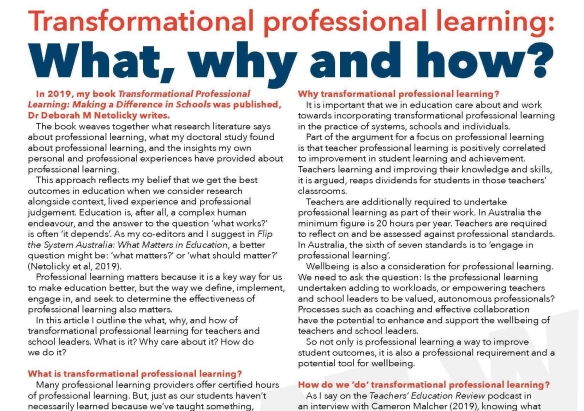
Below is the text of a piece I wrote late last year for the Independent Education magazine on transformational professional learning (Issue 1, Vol 50, 2020, pp.32-33).
I am sharing it here because now, more than ever, teachers and school leaders are changing our practice. This global crisis–and our experiences of emergency teaching, rethinking schooling, distance learning, pandemic pedagogy, redesigning or cancelling assessments, isolation, sickness, empathy and community–is changing what we do and how we do it. We are revisiting the basics such as ‘Maslow before Bloom’, explored here in our independent report on Thinking About Pedagogy in an Unfolding Pandemic (Doucet et al., 2020).
Ways in which professional learning is happening during this pandemic include:
- Job-embedded ‘learning as we go’, trying, iterating and refining practice as we go.
- Colleagues helping colleagues with planning, learning technologies, remote pedagogy, feedback strategies and ways of assessing.
- Webinars offered by professional learning providers.
- Schools, where possible, providing one-on-one, online, or telephone support from IT, either internally or from outside experts.
- Social media platforms in which teachers, school and system leaders, and education organisations around the world are sharing resources, processes and learnings as they address education needs in this uncertain time.
Many may emerge from our current situation having also changed what we believe about teaching, learning, assessing and the purpose of school. As I note in the article, however:
“Teachers and school leaders won’t change practice unless they believe the outcomes for those in their care will be better.”
Are some of the things we are now implementing better for our students? Are we desperate to get back to our old ‘normal’, or are the things we are learning now enhancing equity, improving practice and helping us to make better decisions for students?
As I say in this previous blog post, in considering our ‘next normal’ we can ask ourselves the following questions.
- What is it that we’ve desperately missed that we want to bring back in to schooling and education?
- What is it that’s been removed that we don’t want to return to?
________________________________________
In 2019 my book—Transformational Professional Learning: Making a Difference in Schools—was published. The book weaves together what research literature says about professional learning, what my doctoral study found about professional learning, and the insights my own personal and professional experiences have provided about professional learning. This approach reflects my belief that we get the best outcomes in education when we consider research alongside context, lived experience and professional judgement. Education is, after all, a complex human endeavour, and the answer to the question ‘What works?’ is often ‘It depends’. As my co-editors and I suggest in Flip the System Australia: What Matters in Education, a better question might be: ‘What matters?’ or ‘What should matter?’ (Netolicky et al., 2019).
Professional learning matters because it is a key way for us to make education better, but the way we define, implement, engage in, and seek to determine the effectiveness of professional learning also matters.
In this article I outline the what, why, and how of transformational professional learning for teachers and school leaders. What is it? Why care about it? How do we do it?
What is transformational professional learning?
Many professional learning providers offer certified hours of professional learning. But—just as our students haven’t necessarily learned because we’ve taught something—attending a professional development course or event does not automatically mean that meaningful learning has occurred. In fact, my doctoral research found that professional learning for educators is highly individualised. Those experiences that shape our beliefs and practices can be professional and personal, formal and informal, in and out of educational contexts, and singular and collaborative (Netolicky, 2016a, 2016b).
Transformational professional learning—learning that makes a difference in and for schools—as I define it, is “learning that shifts beliefs, and thereby behaviours, of professionals. It is tied to an individual’s personal and professional identity” (Netolicky, 2020, p.18).
My framing of transformational professional learning draws on the work of Professor Ellie Drago-Severson and Dr Jessica Blum-DeStefano (2018) who describe transformational learning as that which actively changes how a person knows through shifts in cognition, emotion, and capacity. This learning influences our ways of knowing as well as what we know. My definition also resonates with the work of Associate Professor Nicole Mockler (2013) who argues that teachers’ professional learning is deeply tied to who we are, not just what we do or how we do it.
Transformational professional learning acknowledges the complexity and humanity of teaching. Learning that transforms what we do needs to also shape who we think we are as teachers, and what we believe is in the best interests of our students. Teachers and school leaders won’t change practice unless they believe the outcomes for those in their care will be better.
Why transformational professional learning?
It is important that we in education care about and work towards incorporating transformational professional learning in the practice of systems, schools and individuals.
Part of the argument for a focus on professional learning is that teacher professional learning is positively correlated to improvement in student learning and achievement. Teachers learning and improving their knowledge and skills, it is argued, reaps dividends for students in those teachers’ classrooms.
Teachers are additionally required to undertake professional learning as part of their work. In Australia the minimum figure is twenty hours per year. Teachers are required to reflect on and be assessed against professional standards. In Australia, the sixth of seven standards is to ‘engage in professional learning.’
Wellbeing is also a consideration for professional learning. We need to ask the question: Is the professional learning undertaken adding to workloads, or empowering teachers and school leaders to be valued, autonomous professionals? Processes such as coaching and effective collaboration have the potential to enhance and support the wellbeing of teachers and school leaders.
So not only is professional learning a way to improve student outcomes, it is also a professional requirement and a potential tool for wellbeing.
How do we ‘do’ transformational professional learning?
As I say on the Teachers’ Education Review podcast in an interview with Cameron Malcher (2019), knowing what might work best in professional learning helps us to make better decisions. Being informed about what research suggests is most likely to be effective in shaping teacher beliefs and practices, can constructively influence what kinds of professional learning we invest in, and how we go about implementing those for positive results for students, teachers, schools and systems.
The best professional learning—that is, learning most likely to be transformational—comprises a balance of high support and high challenge. It is targeted and ongoing. It is differentiated for context, sector, circumstance and the individual.
In schools and systems, effective professional learning interventions are underpinned by shared vision and are implemented slowly, initially using volunteers, applying judicious measures of success and generating honest feedback from stakeholders to inform, iterate and refine the model for its specific context.
Those professional learning forms backed by research and practice include:
- professional learning communities;
- observation and reflection processes, such as lesson study and instructional rounds;
- post-graduate study;
- mentoring; and
- coaching.
Daily collaboration between teachers within and between schools also fits the brief of collaborative, targeted, ongoing learning, as do long-term relationships between schools and consultants or academics.
Professional learning is one-size-fits-one, so not all transformational professional learning is collaborative or ongoing. Attending a course or conference can also provide an ‘a-ha’ moment for a teacher. Deeply positive or negative professional experiences can change our beliefs and behaviours. Personal experiences, too, such as becoming a parent or travelling, can shape professional identities and shift the ways in which we interact with students and their families.
As is the case for our students, enjoying ourselves or having a nice time does not equal learning. We can feel engaged and energised without learning occurring. We can be in a room with colleagues without effective collaboration actually happening. One thing I have learned as a school leader is to seek out dissenting views and seek to understand them. We need to be okay with discomfort and with respectful, robust disagreement if we are to transform our beliefs and practices for the benefit of our students and communities.
What now?
There is a danger that professional learning is driven by political, corporate or school improvement agendas. Rather than surrendering our professional judgement to those citing league tables, standardised tests or products for sale, we must reclaim professional learning for teachers and school leaders in ways that makes a difference for and with students.
While there is a place for evaluation, we need to focus our efforts on growth, not systems of rewards and punishments that seek to pit teachers and schools against one another. Rhetoric of teachers, schools or education systems ‘failing’, ‘coasting’, ‘flat lining’ and ‘falling behind’, based on oversimplified measures, is unhelpful and harmful. Schools benefit from designing their own measures of the success of professional learning interventions in their own context. Schools can ask: How might we know that conversations are more productive, that teachers are more knowledgeable about teaching strategies, or that the student experience at our school is shifting? Rather than relying on the measures imposed by others, schools can look for indicators of the successes to which they are aspiring, which might be relational, conversational and emotional, rather than numerical or easily quantified.
As I write in Transformational Professional Learning, we teachers and school leaders “are not objects that need professional learning done to us, or incomplete entities requiring development by external forces acting upon us. We are capable professionals who are willing and able to take responsibility for our learning” (2020, p.123). We are not technicians enacting unthinking compliance, but experts looking to grow and develop over time.
In the conclusion, I argue that we need to do the following:
- Consider identity and humanity, because those in schools are human beings and teaching is complex;
- Offer voice and choice, differentiating professional learning for staff at different career stages and with different strengths and aspirations;
- Focus on context, culture, and relationships;
- Enable collaboration that is rigorous, purposeful, and sometimes uncomfortable;
- Broaden our definition of professional learning; and
- Invest time, money, and resources into professional learning.
Professional learning should empower, enrich and sustain our profession, not undermine, stifle or demoralise it. So, let’s focus on building and refining cultures of trust, collaboration, and vibrant professional conversation. Let’s give teachers the space, time and resources to identify and improve their knowledge, skills and understandings. Let’s work towards being and becoming the best educators we can be, by simultaneously pursuing individual goals, organisational goals, and the greater good.
References
Drago-Severson, E., & Blum-DeStefano, J. (2018). Leading change together: Developing educator capacity within schools and systems. Alexandria: ASCD.
Malcher, C. (2019). 2019, 27 October. Teachers’ Education Review [Audio podcast]. ‘TER #141 – Transformational Professional Learning with Deborah Netolicky’ Retrieved from: https://soundcloud.com/ter-podcast/ter-141-transformational .
Mockler, N. (2013). Teacher professional learning in a neoliberal age: Audit, professionalism and identity. Australian Journal of Teacher Education, 38(10), 35-47.
Netolicky, D. M. (2020). Transformational professional learning: Making a difference in schools. Abingdon: Routledge.
Netolicky, D. M. (2016a). Down the rabbit hole: Professional identities, professional learning, and change in one Australian school (Doctoral dissertation, Murdoch University).
Netolicky, D. M. (2016b). Rethinking professional learning for teachers and school leaders. Journal of professional capital and community, 1(4), 270-285.
Netolicky, D. M., Andrews, J., & Paterson, C. (Eds.). (2019). Flip the System Australia: What Matters in Education. Abingdon: Routledge.












